Abstract
Nickel (Ni) is an environmental pollutant towards which human exposure can be both occupational (mainly through inhalation) and dietary (through water and food chain-induced bioaccumulation). The aim of this study was to investigate the effects of short-term Ni-administration (as NiCl2, 13 mg/kg) on the adult rat whole brain total antioxidant status (TAS) and the activities of acetylcholinesterase (AChE), Na+,K+-ATPase, and Mg2+-ATPase; in addition, the potential effect of the co-administration of the antioxidant L-cysteine (Cys, 7 mg/kg) on the above parameters was studied. Twenty-eight male Wistar rats were divided into four groups: A (saline-treated control), B (Ni), C (Cys), and D (Ni and Cys). All rats were treated once daily with intraperitoneal injections of the tested compounds, for 1-week. Rats were sacrificed by decapitation and the above-mentioned parameters were measured spectrophotometrically. Rats treated with Ni exhibited a significant reduction in brain TAS (-47%, p < 0.001, BvsA) that was efficiently limited by the co-administration of Cys (-4%, p > 0.05, DvsA; +83%, p < 0.001, DvsB), while Cys (group C) had no effect on TAS. The rat brain AChE activity was found significantly increased by both Ni (+30%, p < 0.001, BvsA) and Cys (+62%, p < 0.001, CvsA), while it tended to adjust to control levels by the co-administration of Ni and Cys (+13%, p < 0.001, DvsA; −13%, p < 0.001, DvsB). The activity of rat brain Na+,K+-ATPase was significantly decreased by Ni-administration (−49%, p < 0.001, BvsA), while Cys supplementation could not reverse this decrease (-44%, p < 0.001, DvsA). The activity of Mg2+-ATPase was not affected by Ni-administration (−3%, p > 0.05, BvsA), but was significantly reduced when combined with Cys administration (−17%, p < 0.001, DvsA). The above findings suggest that Ni short-term in vivo administration causes a statistically significant decrease in the rat brain TAS and an increase in AChE activity. Both effects can be, partially or totally, reversed to control levels by Cys co-administration; Cys could thus be considered (for future applications) as a potential neuroprotective agent against chronic exposure to Ni. The activity of Na+,K+-ATPase that was inhibited by Ni, could not be reversed by Cys co-administration. The matter requires further investigation in order to fully elucidate the spectrum of the neurotoxic effects of Ni.

Similar content being viewed by others
References
Obone E, Chakrabarti SK, Bai C, Malick MA, Lamontagne L, Subramanian KS (1999) Toxicity and bioaccumulation of nickel sulphate in Sprague-Dawley rats following 13 weeks of subchronic exposure. J Toxicol Environ Health A 57:379–401
Zawisza-Raszka A, Dolezych B (2008) Acetylcholinesterase, catalase and glutathione S-transferase activity in beet armyworm (Spodoptera exigua) exposed to nickel and/or diazinon. Acta Biol Hung 59:31–45
Goyer RA (1986) Toxic effects of metals. In: Klaassen CD, Amdur MO, Doull J (eds) Casarett and Doull’s Toxicology: The Basic Science of Poisons. MacMillan, New York, pp 623–680
Evans JE, Miller ML, Andringa A, Hastings L (1995) Behavioral, histological, and neurochemical effects of nickel (II) on the rat olfactory system. Toxicol Appl Pharmacol 130:209–220
Coogan TP, Latta DM, Snow ET, Costa M (1989) Toxicity and carcinogenicity of nickel compounds. Crit Rev Toxicol 19:341–384
Furst A (1984) Mechanism of action of nickel as a carcinogen: needed information. IARC Sci Publ 53:245–252
Costa M, Abbracchio MP, Simmons-Hansen J (1981) Factors influencing the phagocytosis, neoplastic transformation, and cytotoxicity of particulate nickel compounds in tissue culture systems. Toxicol Appl Pharmacol 60:313–323
Benson JM, Carpenter RL, Hahn FF, Haley PJ, Hanson RL, Hobbs CH, Pickrell JA, Dunnick JK (1987) Comparative inhalation toxicity of nickel subsulfide to F344/N rats and B6C3F1 mice exposed for 12 days. Fundam Appl Toxicol 9:251–265
Benson JM, Burt DG, Carpenter RL, Eidson AF, Hahn FF, Haley PJ, Hanson RL, Hobbs CH, Pickrell JA, Dunnick JK (1988) Comparative inhalation toxicity of nickel sulfate to F344/N rats and B6C3F1 mice exposed for twelve days. Fundam Appl Toxicol 10:164–178
Sunderman FW Jr (2001) Nasal toxicity, carcinogenicity, and olfactory uptake of metals. Ann Clin Lab Sci 31:3–24
Adams RG, Crabtree N (1961) Anosmia in alkaline battery workers. Br J Ind Med 18:216–221
Henriksson J, Tallkvist J, Tjälve H (1997) Uptake of nickel into the brain via olfactory neurons in rats. Toxicol Lett 91:153–162
Tallkvist J, Henriksson J, d'Argy R, Tjälve H (1998) Transport and subcellular distribution of nickel in the olfactory system of pikes and rats. Toxicol Sci 43:196–203
Shi Z (1994) Nickel carbonyl: toxicity and human health. Sci Total Environ 148:293–298
Kita H, Van der Kloot W (1973) Action of Co and Ni at the frog neuromuscular junction. Nat New Biol 245:52–53
Fatehyab S, Hasan M, Hasan MZ, Anwar J (1980) Effect of nickel on the levels of dopamine, noradrenaline and serotonin in different regions of the rat brain. Acta Pharmacol Toxicol Copenh 47:318–320
Kouniniotou-Krontiri P, Tsakiris S (1989) Time dependence of Li+ action on acetylcholinesterase activity in correlation with spontaneous quantal release of acetylcholine in rat diaphragm. Jpn J Physiol 39:429–440
Bogdanski DF, Tissari A, Brodie BB (1968) Role of sodium, potassium, ouabain and reserpine in uptake, storage and metabolism of biogenic amines in synaptosomes. Life Sci 7:419–428
Hernandez J (1987) Brain Na+, K + -ATPase activity possibly regulated by a specific serotonin receptor. Brain Res 408:399–402
Lees GJ, Lehmann A, Sandberg M, Hamberger A (1990) The neurotoxicity of ouabain, a sodium-potassium ATPase inhibitor, in the rat hippocampus. Neurosci Lett 120:159–162
Mata M, Fink DJ, Gainer H, Smith CB, Davidsen L, Savaki H, Schwartz WJ, Sokoloff L (1980) Activity-dependent energy metabolism in rat posterior pituitary primarily reflects sodium pump activity. J Neurochem 34:213–215
Sastry BS, Phillis JW (1977) Antagonism of biogenic amine-induced depression of cerebral cortical neurones by Na+, K + -ATPase in inhibitors. Can J Physiol Pharmacol 55:170–179
Swann AC (1984) (Na+, K+)-adenosine triphosphatase regulation by the sympathetic nervous system: effects of noradrenergic stimulation and lesion in vivo. J Pharmacol Exp Ther 228:304–311
Sanui H, Rubin H (1982) The role of magnesium in cell proliferation and transformation. In: Boynton AL, McKochan WL, Whitfield JP (eds) Ions, Cell Proliferation and Cancer. Academic Press, New York, pp 517–537
Carageorgiou H, Tzotzes V, Pantos C, Mourouzis C, Zarros A, Tsakiris S (2004) In vivo and in vitro effects of cadmium on adult rat brain total antioxidant status, acetylcholinesterase, (Na+, K+)-ATPase and Mg2 + -ATPase activities: protection by L-cysteine. Basic Clin Pharmacol Toxicol 94:112–118
Patrick L (2003) Toxic metals and antioxidants: Part II. The role of antioxidants in arsenic and cadmium toxicity. Altern Med Rev 8:106–128
Council EEC (1986) EEC Council Directive 86/609/EEC of 24 November 1986 on the approximation of laws, regulations and administrative provisions of the Member States regarding the protection of animals used for experimental and other scientific purposes. Off J Eur Union L358:1–28
Yan XM, Tao ZQ, Liang YY, Chen ZJ, Zhang JS, Xu XH (1998) Effect of catecholamic acid on detoxication and distribution of NiCl2 in mice and rats. Zhongguo Yao Li Xue Bao 19:80–84
Tsakiris S (2001) Effects of L-phenylalanine on acetylcholinesterase and Na+, K + -ATPase activities in adult and aged rat brain. Mech Ageing Dev 122:491–501
Tsakiris S, Angelogianni P, Schulpis KH, Behrakis P (2000) Protective effect of L-cysteine and glutathione on rat brain Na+, K + -ATPase inhibition induced by free radicals. Z Naturforsch C 55:271–277
Lowry OH, Rosebrough NJ, Farr AL, Randall RJ (1951) Protein measurement with the Folin phenol reagent. J Biol Chem 193:265–275
Carageorgiou H, Zarros A, Tsakiris S (2003) Selegiline long-term effects on brain acetylcholinesterase, (Na+, K+)-ATPase activities, antioxidant status and learning performance of aged rats. Pharmacol Res 48:245–251
Carageorgiou H, Pantos C, Zarros A, Mourouzis I, Varonos D, Cokkinos D, Tsakiris S (2005) Changes in antioxidant status, protein concentration, acetylcholinesterase, (Na+, K+)- and Mg2 + -ATPase activities in the brain of hyper- and hypothyroid adult rats. Metab Brain Dis 20:129–139
Ellman GL, Courtney KD, Andres V Jr, Featherstone RM (1961) A new and rapid colorimetric determination of acetylcholinesterase activity. Biochem Pharmacol 7:88–95
Bowler K, Tirri R (1974) The temperature characteristics of synaptic membrane ATPases from immature and adult rat brain. J Neurochem 23:611–613
Kawanishi S, Inoue S, Yamamoto K (1994) Active oxygen species in DNA damage induced by carcinogenic metal compounds. Environ Health Perspect 102:17–20
Novelli EL, Rodrigues NL, Ribas BO (1995) Superoxide radical and toxicity of environmental nickel exposure. Hum Exp Toxicol 14:248–251
Carageorgiou H, Tzotzes V, Sideris A, Zarros A, Tsakiris S (2005) Cadmium effects on brain acetylcholinesterase activity and antioxidant status of adult rats: modulation by zinc, calcium and L-cysteine co-administration. Basic Clin Pharmacol Toxicol 97:320–324
Liapi C, Zarros A, Galanopoulou P, Theocharis S, Skandali N, Al-Humadi H, Anifantaki F, Gkrouzman E, Mellios Z, Tsakiris S (2008) Effects of short-term exposure to manganese on the adult rat brain antioxidant status and the activities of acetylcholinesterase, (Na+, K+)-ATPase and Mg2 + -ATPase: modulation by L-cysteine. Basic Clin Pharmacol Toxicol 103:171–175
Liapi C, Zarros A, Theocharis S, Al-Humadi H, Anifantaki F, Gkrouzman E, Mellios Z, Skandali N, Tsakiris S (2009) The neuroprotective role of L-cysteine towards the effects of short-term exposure to lanthanum on the adult rat brain antioxidant status and the activities of acetylcholinesterase, (Na+, K+)- and Mg2 + -ATPase. Biometals 22:329–335
Frasco MF, Fournier D, Carvalho F, Guilhermino L (2005) Do metals inhibit acetylcholinesterase (AChE)? Implementation of assay conditions for the use of AChE activity as a biomarker of metal toxicity. Biomarkers 10:360–375
Miszta H, Dabrowski Z, Szyguła Z, Spodaryk K (1986) The effect of intrarenal nickel subsulfide injections upon the activity of selected erythrocyte and bone marrow enzymes in rats. Acta Pharmacol Toxicol Copenh 59:425–429
Bag S, Vora T, Ghatak R, Nilufer I, D’mello D, Pereira J, Cutinho C, Rao V (1999) A study of toxic effects of heavy metal contaminants from sludge-supplemented diets on male Wistar rats. Ecotoxicol Environ Saf 42:163–170
Tsangaris C, Papathanasiou E, Cotou E (2007) Assessment of the impact of heavy metal pollution from a ferro-nickel smelting plant using biomarkers. Ecotoxicol Environ Saf 66:232–243
Repetto G, del Peso A, Sanz P, Repetto M (2001) In vitro effects of lithium and nickel at different levels on Neuro-2a mouse neuroblastoma cells. Toxicol In Vitro 15:363–368
Asthana RK, Singh SP, Singh RK (1992) Nickel effects on phosphate uptake, alkaline phosphatase, and ATPase of a cyanobacterium. Bull Environ Contam Toxicol 48:45–54
Acknowledgments
This study was funded by the University of Athens. Many thanks are expressed to the medical students John Botis and Vasilios Memtsas as well as to Vasileios Stolakis (BSc) for their assistance.
Author information
Authors and Affiliations
Corresponding author
Rights and permissions
About this article
Cite this article
Liapi, C., Zarros, A., Theocharis, S. et al. Short-Term Exposure to Nickel Alters the Adult Rat Brain Antioxidant Status and the Activities of Crucial Membrane-Bound Enzymes: Neuroprotection by L-Cysteine. Biol Trace Elem Res 143, 1673–1681 (2011). https://doi.org/10.1007/s12011-011-9006-0
Received:
Accepted:
Published:
Issue Date:
DOI: https://doi.org/10.1007/s12011-011-9006-0




